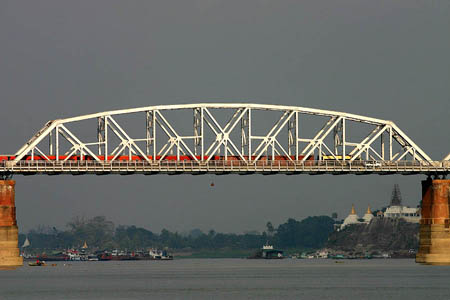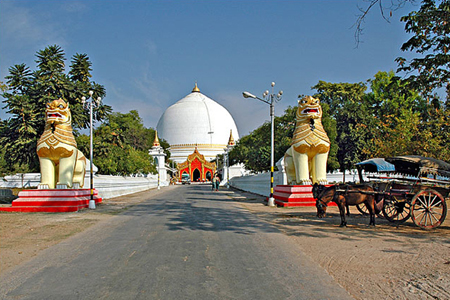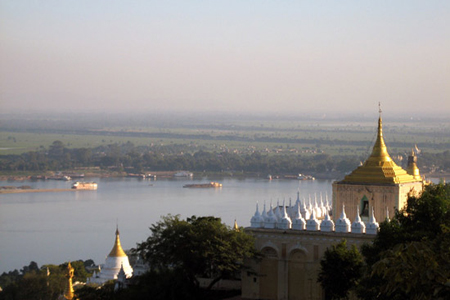Like other capital cities, Sagaing, preceding Ava, records a brief and chequered history that worth a visit on a day trip from Mandalay to explore. Athin Khaya, a Shan chieftain, made Sagaing his capital in 1322 A.D, when he set himself up independently, having freed himself from the over-lordship of the Shan Kingdom of Pinya. It was his grandson, Thado Minbya, who transferred the capital to Ava and became the first King of Ava. Alaung- paya’s first son, Naungdawgyi had his capital again at Sagaing for four years (1760-1764) and, when he died, Ava, once again, became the seat of royalty.
On the road to Sagaing from Mandalay, before one actually enters the town is the magnificent one-mile long Ava Bridge, across the Irrawaddy, over which flow both road and rail traffic, the rail track in the middle and two roads (13 feet wide) on either side. Put into commission in 1934, it has sixteen spans of varying lengths, two of which were pulled down by the British in Burma in the course of their operations against the Japanese in World War II. The reconstructed bridge was re-opened for traffic on the 27th October 1954 by Burma’s President, Dr. Ba U, amidst national rejoicing and symbolizing the increasing tempo of rehabilitation.

The Bridge, the river and the cliffs in the background form a landscape of ineffable beauty.
At the foot of the bridge, that is, before one gets on to it, to the left, there are the ruins of an old Fort – Thabyedan.
Of the capital, as in the case of Amarapura, and Ava, the walls are the only remaining witness. Noteworthy pagodas there are Kaung Hmu Daw, otherwise known as Rajamanicola, the most distinguished among them, six miles out of the town. Facing this pagoda is a lake which came to be when the area was dug up for earth to make bricks to build the shrine and this lake is now being pressed into service as an experimental fishery. Behind the pagoda is a sacred or sanctified pond with a parapet wall all round Myitta Kan and it is said that no autumnal leaves from the nearby trees ever fall into it!
Built by King Thalun in 1636 to commemorate the re-establishment of Ava as the royal capital, Kaung Hmu Daw, what with its size, fills the landscape and figures as a landmark in central Myanmar for miles around. Akin to the Indian type of topes, this hemispherical pagoda is modeled on the Mahaceti of Ceylon. With a mammoth dome and an equally impressive umbrella (hti) on top and standing on three circular terraces and with a base circumference of 400 feet, the shrine goes up to a height of 151 ½ feet.
Along the base, you find hollowed-out recesses housing figures of nats (spirits) or devas (celestial beings). The most remarkable feature of this pagoda is the original arrangement for flood-lighting made through 812 stone posts, 4ị feet high, with niches for oil lamps, to be found on all the four sides. When actually lighted in that manner, it must present a most entrancing spectacle-an oriental festival of lamps. There is also an 8 ½ feet high marble stone inscription, in Burmese script, in one corner of the innermost yard, giving the details with respect to the building of the pagoda. The repository of the shrine is reputed to contain the left lower tooth of the Buddha brought from Ceylon and King Dhamma- pala’s emerald begging bowl. Kaung Hmu Daw is a greatly-venerated pagoda in Upper Burma.

Among the other pagodas, the Ngadatkyi to the west of the town, built in 1657 A.D., houses a superb and colossal sitting image of the Buddha. There is the uncompleted Tũpãyon, sponsored by the Ava King, Narapati, in 1444 A.D., standing 90 feet high, an architectural type rarely to be seen in Burma, circular in plan and with three storeys, marked by vertical or dormer window-like hollows with niches. (In a shed next-door is a rich collection of inscription stones of the 14th and 15th centuries).
The Aung Mye Lawk A, built in 1783 A.D. by Bodawpaya, on the ground on which his residence stood before he ascended the throne, stands on the riverfront (near the Civil Hospital). Its distinguishing feature is that it is wholly built of sandstone and designed to emulate the Shwezigon Pagoda at Nyaung-Oo (Pagan). It has a slender spire and is cylindrical in form. You see five pairs of leogryphs.
The Datpaungzu houses relics collected from all the pagodas which were dismantled to make room for a railroad. The Hsin Mya Shin Pagoda or the Pagoda of Many Elephants, on the way from the town to Kaung Hmu Daw, is another notable shrine.
In and around Sagaing there are hundreds of pagodas and monasteries to explore in tours to Burma. Actually, the area is a noted seat of Buddhism in Upper Burma, next to Mandalay. A typical monastery is Pa Bã Gyaung, nestling on the slope of a hill, carrying a signboard, for want of a better phrase, in front, in Burmese, translatable in English: “Of the original nine, this is the first It is over nine hundred years old and an ideal spot for undisturbed meditation. Going up to it, you hear the chanting of hymns from all sides and novices, in the traditional semi-recumbent posture, with their legs tucked in and poised on their elbows, taking their lessons in Buddha Dhamma from the Sayadaw or some other learned monk. A visit to this famous monastery is worth-while-you get a realistic picture of Buddhist monastic life as practiced in this part of the world, an idea of the hold that Theravada Buddhism has on the people of Burma and how, for centuries, Buddhism has been nursed and fostered.

Of interest to tourists, there is the old fort on the right bank of the river-the walls of the fort are seen in a, more or less, dilapidated condition where the Burmese put up a last-ditch resistance against the British Forces during their operations culminating in the annexation of Upper Burma. This is the place where the bodies of British soldiers lay buried for some time till they were removed elsewhere. As you climb the old wall, you see the Irrawaddy, the Ava Bridge, and the Sagaing and Mandalay Hills. A couple of miles out of Sagaing town is the village of Ywataung where, for generations on end, skilled craftsmen have produced silver-ware for which Burma has built up a well-merited reputation for herself. Here you will find the silver-workers at their forges or out in the yard inscribing, on silver bowls and things, with the know-how handed to them, father to son, foliage, and scenes from the life of the Buddha, the Burmese astronomical chart, court scenes and so on.
